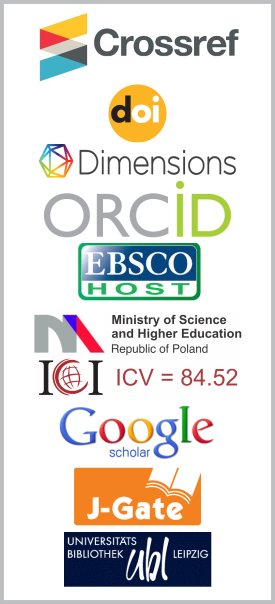Tungsten Inert Gas Welding of Al-Mg Alloys With and Without Scandium Addition
DOI:
https://doi.org/10.26713/jims.v10i3.1206Keywords:
Tungsten inert gas welding, AA5083-H321 alloy, Scandium, Tensile propertiesAbstract
In this study, a comparative evaluation of Tungsten Inert Gas (TIG) welding on two different alloys, one with the addition of rare earth metal Scandium and the other alloy without the addition of scandium was undertaken. The Innovative Recycled Cast Al-Mg-Sc alloy has been prepared using Vacuum Induction Melting Casting Furnace, which is available in India and the TIG welding process was applied over it. Microstructural examination revealed that both welds contain shrinkage voids and porosity in the weld zone. Brittle dendrites formed in the wrought alloy without scandium reduces the yield stress to a very low level. Very fine grains formed in the cast Al-Mg-Sc alloy TIG welded joint and the nature of non-dendritic grains formed are responsible for the enhancement of yield stress. The weld tensile properties of cast scandium added aluminum-magnesium alloy plates were found out to be better than the wrought alloy plate. These results clearly show that Cast Al-Mg-Sc alloy compared to Wrought AA5083-H321 alloy is good for industrial applications.Downloads
References
H.E. Adkins and R.A. Ridout, Welding Engineer 84 (1969).
D.K. Rajesh Manti, A. Dwivedi and J. Agarwal, J. of Mater. Eng. Perform. 17(5) (2008), 667 – 673.
T. Aiura, N. Sugawara and Y. Miura, Mater. Sci. Eng A. A280 (2000), 139 – 145.
B. Lenczowski, T. Hack, D. Wieser, G. Tempus, G. Fischer, J. Becker, K. Folkers, R. Braun and G. Lutjering, Mater. Sci. Forum 331-337 (2000), 957 – 964.
I.I. Velichko, G.V. Dodin, B.K. Metelev and N.I. Sotnikov, Int. Conference: Scandium and Prospects of its Use, Moscow, 18-19, p. 14 (1994).
L.A. Wiley, US-Patent 3 619 181 (1971).
A.C. Munoz, G. Ruckert, B. Huneau, X. Sauvage, S. Marya and J. Mater, Process. Technol. 197 (2008), 337 – 343.
J. Zhao, F. Jiang, H. Jian, K. Wen, L. Jiang and X. Chen, Materials and Design 31 (2010), 306 – 311.
Z.-B. He, Y.-Y. Peng, Z.-M. Yin and X.-F. Lei, Trans. Nonferrous Met. Soc. China 21 (2011), 1685 – 1691.
D. Zhemchuzhnikova, S. Mironov and R. Kaibyshev, Fatigue Performance of Friction-Stir-Welded Al-Mg-Sc Alloy, Metall. Mater. Trans. A 48A (2017), 150 – 158.
K. Subbaiah, Studies on Friction-Stir and Fusion Welding of Aluminum-Magnesium based Alloys, Ph.D Thesis, VIT University (2014).
K.S. Rao, P.N. Raju, G.M. Reddy and K.P. Rao, Trans. Indian Inst. Metals 63(2-3) (2010), 379 – 384.
R. Prokic-Cvetkovic, S. Kastelec-Macura, A. Milosavljevic, O. Popovic and M. Burzic, J. Min. Metall. Sect. B - Metall. 46(2) B, 193 – 202 (2010).
S. Kastelec-Macura, R. Prokic-Cvetkovic, R. Jovicic, O. Popovic and M. Burzic, Structural Integrity and Life 8(2) (2008), 114 – 120.
E. Taban and E. Kaluc, Kovevo Mater. 45 (2007), 241 – 248.
O. Roder, O. Schauerte, G. Lutjering and A. Gysler, Mater. Sci. Forum 217-222 (1996), 1835 – 1840.
G. Lutjering and A. Gysler, in Al. Alloys-Physical and Mechanical Properties, EMAS, Warley 1547 (1986).
K.S. Prasad, A.K. Mukhopadhay, B. Majumdar, D. Akhtar, J. Mater. Manuf. Process 23(7) (2008), 658 – 664.
J.-Z. Dang, Y.-F. Huang and J. Cheng, Effect of Sc and Zr on microstructure and mechanical properties of as-cast Al-Mg-Si-Mn alloys, Trans. Nonferrous Met. Soc. China 19 (2009), 540 – 544.
R.K. Shukla and P.K. Shah, Indian J Sci. Technol. 3(6) (2010), 667 – 671.
A. Hirose, H. Todaka and K.F. Kobayashi, Metall. Mater. Trans. A 28A (1997), 2657 – 2662.
A.K. Lakshminarayanan, V. Balasubramanian and K. Elongovan, Int. J. Adv. Manuf. Technol. 40 (2009), 286 – 296.
A. Punkari, D.C. Weckman and H.W. Kerr, Sci. Technol. Weld. Join 8 (2003), 269.
Downloads
Published
How to Cite
Issue
Section
License
Authors who publish with this journal agree to the following terms:- Authors retain copyright and grant the journal right of first publication with the work simultaneously licensed under a CCAL that allows others to share the work with an acknowledgement of the work's authorship and initial publication in this journal.
- Authors are able to enter into separate, additional contractual arrangements for the non-exclusive distribution of the journal's published version of the work (e.g., post it to an institutional repository or publish it in a book), with an acknowledgement of its initial publication in this journal.
- Authors are permitted and encouraged to post their work online (e.g., in institutional repositories or on their website) prior to and during the submission process, as it can lead to productive exchanges, as well as earlier and greater citation of published work.




